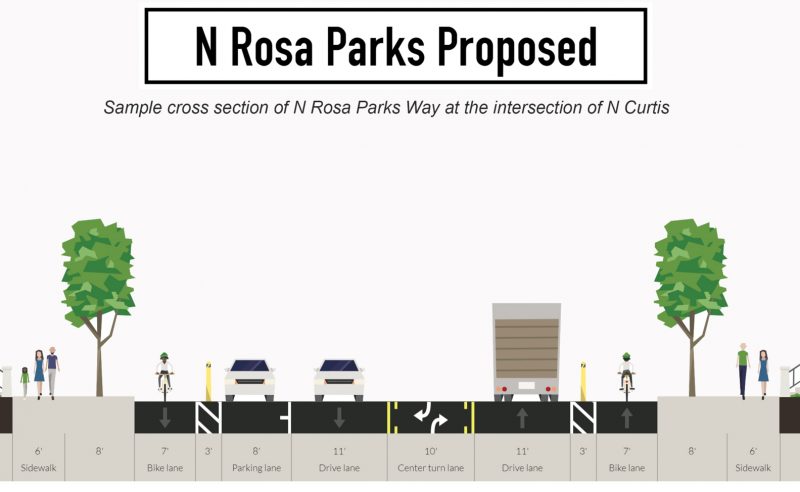
A key east-west street in north Portland is poised for a makeover.
The Portland Bureau of Transportation will piggyback on a maintenance and paving project to add protected bike lanes and other upgrades to North Rosa Parks Way.
As detailed in their just-updated project website, the plan is to update Rosa Parks from North Willamette to Martin Luther King Boulevard. That’s a nearly two-mile section of road that crosses five major north-south bikeways (Williams, Vancouver, Concord, Michigan and Willamette), four schools (Growing Seeds, Chief Joseph, Ockley Green, and Holy Redeemer) and two parks (Peninsula and Arbor Lodge). Other destinations include the Yellow Line MAX stations, New Seasons Market and other businesses at Interstate, restaurants and markets at Denver, a medical clinic at Greeley and more.

Most notably, the City has proposed to create 10-foot wide bike lanes on both sides of the street between Delaware and Willamette (design proposals for the rest of the project haven’t been released yet). The north side would be “parking protected” — meaning auto-parking spaces would float in the street between the curbside bike lane and standard lanes. On the south side, PBOT would prohibit on-street parking. The bike lanes would have a three-foot buffer zone with plastic curbs and delineator wants within it.
Here’s the proposed striping from Willamette to Curtis:
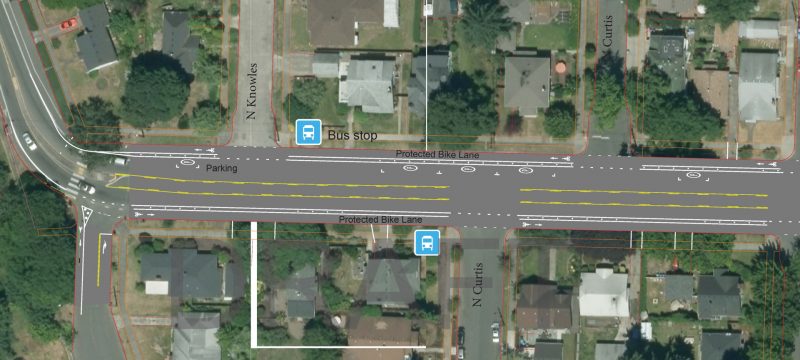
Advertisement
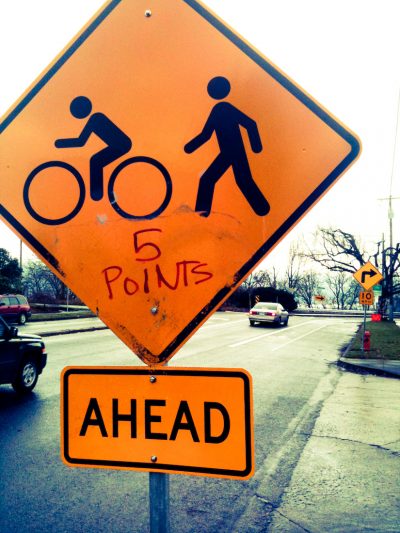
PBOT is doing this because they recognize the growing importance of Rosa Parks as a bikeway, they realize it should be used more efficiently — and most importantly, they know the street’s current design leads to people driving way too fast which has resulted in too many injuries and fatalities.
In the 10 years from 2006 to 2015, PBOT counts 19 people who have either been injured or killed in crashes while using the corridor. 11 of those collisions involved people bicycling — with nine of them happening between Willamette and Interstate. In 2008 we reported on a serious injury crash at North Albina. And Since 2016 two separate crashes at North Delaware led to fatality and injury. One of those crashes paralyzed Arbor Lodge resident Brian Duncan.
PBOT cites speeding as one of the main reasons they want to change the design of the street. When they analyzed speeds at North Curtis in 2013 they found the average person was driving 32 mph (two miles over the posted speed limit). “Considering that people are driving from or towards a sharp turn at Willamette,” they write on the project website, “the speeds are particularly high.”
This section of Rosa Parks also allows on-street auto parking on both sides of the street; but PBOT says that’s valuable space that is currently being used “inefficiently”. Citing the same “low parking utilization” rationale they used prior to removing on-street parking on Willamette Boulevard late last year, PBOT said a recent study showed a paltry 17 percent parking occupancy rate on Rosa Parks between Willamette and Delaware. “Only one block face out of 12 had more than half of the spaces used… while four block faces had 0 percent occupancy.”

(Photos: J. Maus/BikePortland)
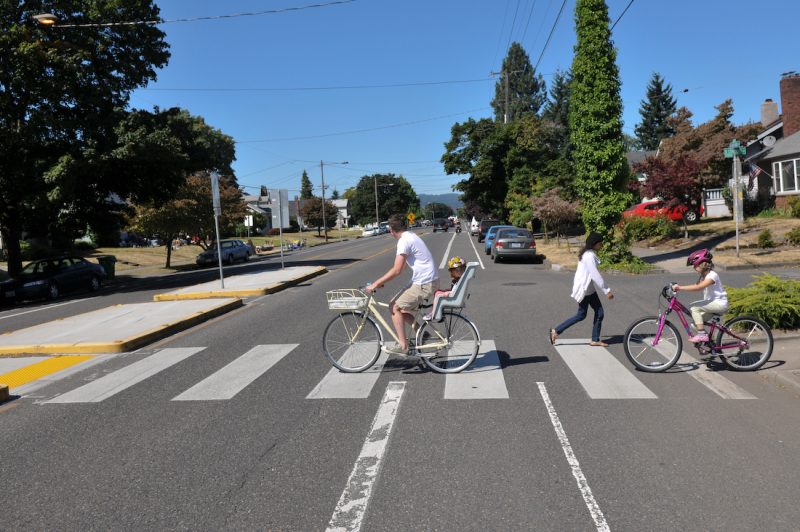
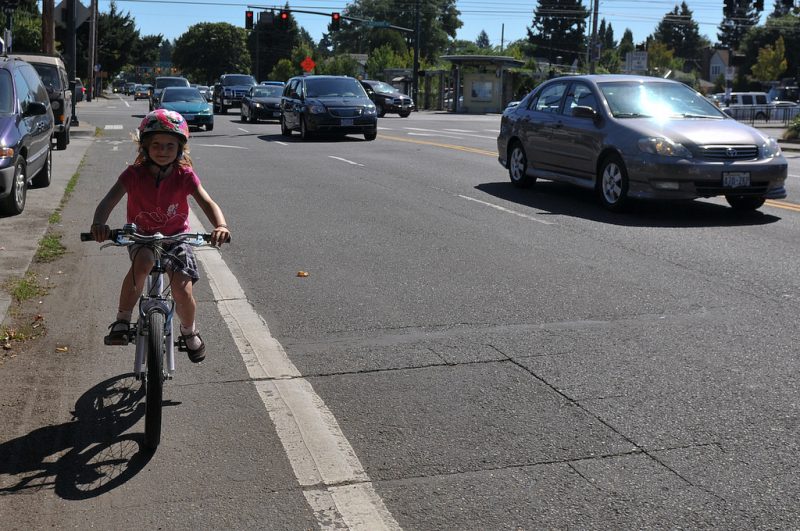
Given these current conditions PBOT wants the street to include new crossings, improved transit infrastructure at several locations, and protected bike lanes. “These changes will emphasize the neighborhood character of the street,” their letter said. “A street design with a more neighborhood feel.”
At this point, PBOT says they haven’t finalized designs because they’re, “Currently doing outreach to the neighborhood to better understand community needs and preferences.”
Rosa Parks currently has standard, unprotected, door-zone bike lanes that were installed in 2011.
We’ll be following this project closely. As a nearby resident I’ve watched cycling conditions worsen on Rosa Parks in recent years as driver behavior has gotten worse and the amount of people in cars has increased dramatically. The biggest danger spots PBOT will have to address in this project are where Rosa Parks crosses I-5 — an area roughly from North Mississippi to Concord. As a section with daily peak-hour gridlock due to on-ramps and off-ramps to the freeway, PBOT will have to get some of the designs approved by the Oregon Department of Transportation.

One particularly troublesome spot is at Rosa Parks and Michigan where the road increases to two standard lanes westbound just prior to the freeway on-ramp. Every day during rush-hour the road backs up as northbound freeway traffic backs up into the neighborhood. As you can see in the photos above, in order to let through-traffic get by, drivers will move over onto the existing bike lane (which is clearly illegal) so that other drivers can get around them. This blocks the bike lane and causes dangerous interactions. PBOT is aware of this problem and they’ve said we can expect it to be addressed in this project.
If you ride on Rosa Parks Way and want to share your feedback with PBOT, email Project Manager Scott Cohen at scott.cohen [at] portlandoregon.gov.
— Jonathan Maus: (503) 706-8804, @jonathan_maus on Twitter and jonathan@bikeportland.org
Never miss a story. Sign-up for the daily BP Headlines email.
BikePortland needs your support.




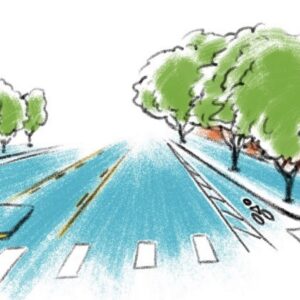
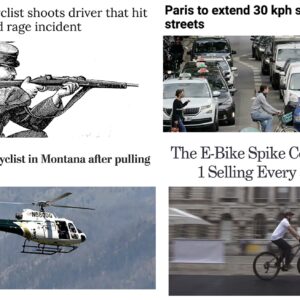

This road will not suffer from being one lane in each direction.
This plan actually increases the number of lanes.
Pretty good design. Thanks PBOT! The achilles heel of PBLs is a lack of visibility and physical protection at the intersections resulting in hooks. Extend the bollards further into the crosswalk to necessitate a 90 degree turn by cars. Typically we get this only with sneckdowns, but it should be standard design. Or maybe we can just hire a few Dutch engineers?
Love to see something like this on Skidmore too!
I was thinking the same thing! It bike facilities were completed, Skidmore would connect so many great bike facilities, neighborhoods and commercial districts using existing, safe traffic signals and a direct route. I love this proposal for Rosa Parks, and I am sure it will be a success. Hopefully this will add even more momentum to close the gap on Willamette (north to Richmond) and finish the bike lanes (from Michigan to 7th) on Skidmore
YES PLEASE!
Without removing the highway interchange completely they will never satisfactorily address the conflicts that occur in this area.
PBOT did a fantastic job with signal separation on the Eastbound stretch just West of I-5. The same could be done with the Westbound signal.
Not so great if you are riding north to Freddies.
I think removing the freeway ramps should be an option on the table. They are incompatible with the “neighborhood feel” PBOT says they want.
I agree, but they are probably within the portfolio of ODOT, which will be unlikely to want to inconvenience its paying customers, the trucking industry.
This is great news. For too long I have used Ainsworth because of the high traffic speeds on Rosa Parks. The photos of the cars blocking the bike lane in their desperate attempt to get to the on ramp, reminded me of what a college friend of mine liked to say,” Never get between a motor junkie and their freeway fix.”
Same — and as we’ve raised up three kids as cyclists, all of them also prefer Ainsworth because of the lower traffic speeds. These are great improvements to Rosa Parks.
I switched to N Ainsworth as well. It’s not just the lower traffic speed though, there are fewer traffic signals on N Ainsworth, no freeway ramps, and if you’re coming from N Williams, you’re not trying to turn left onto N Rosa Parks without a signal. I will probably stick to N Ainsworth even after this project is completed.
Where the parking floats (is to the left of the bike lane) will the bus stops also float?
I can’t wait for this to be completed. Thank you, PBOT!
I really hate the idea of riding between parked cars and the sidewalk. Talk about not being seen… the physical barrier aspect isn’t worth the low visible exchange. SW/NW 2nd does this and I stay far, far away from it.
The whole point of “being seen” is so the cars don’t run you over. With physical protection from cars, you don’t need to be seen…you’re protected from them
Sure, if you’re only going a block. However, since you’re almost certainly bound to cross an intersection eventually, these so-called parking protected bike lanes just add risk at the most dangerous part of the trip, the intersection. Overall, I think they subtract a small risk factor and add a larger one for a net loss of safety.
Let’s put it another way: You could just ride on the sidewalk in many places and be both parking and grade protected from traffic. Why doesn’t anyone do that? Likely because it is so obviously dangerous at every intersection and driveway that it is rejected out of hand. I’ll grant that it might work in a different social context, like where motorists have reasonable training and knowledge standards and enforcement is ubiquitous, but we don’t live in that setting.
You are correct IF protected intersections are left out (unfortunately represented in the above project). NY is going through a steep learning curve with PBLs, and not coincidentally, a steep bike mode share increase as well.
Parking protection often ends with “merging zones” at intersections. This means people in cars can cut the corners on a wide fast arc. Given protected intersections people in cars must make a slow 90 degree turn. NYC DOT has many of these, but it needs to become standard practice. Their data suggests it is safer for pedestrians and bikes.
if PBOT prevented people from parking within ~100 feet of a right-turn intersection much of this risk would be mitigated. unfortunately, subsidized vehicle storage is PBOT’s third rail.
see slide 24 from a PBOT presentation from 2009 for an illustration of how mere paint can greatly enhance safety:
https://www.portlandoregon.gov/transportation/article/228196
Plastic wands. A visual reminder of what PBOT isn’t willing to do to make truly safe facilities for 8-80.
It’s an enormous step in the right direction. If we waited for concrete on every project, we’d have one or two projects a year. Here they simply keep people from parking in the bike lane and hopefully provide ped islands at intersections if we can get PBOT to alter the design.
there are similarly inexpensive options that serve as far more effective barriers to encroachment. for example, larger bumps or thicker bollards: https://peopleforbikes.org/blog/protected-bike-lanes-do-not-cost-1-million-per-mile/
i suspect that the main reason these are not considered is that pbot is reluctant to use “barriers” that might damage motorvehicles.
Illustrations from Sevilla:
http://farm3.staticflickr.com/2869/8989452259_33a74324c9.jpg
“I’ll grant that it might work in a different social context, like where motorists have reasonable training and knowledge standards and enforcement is ubiquitous, but we don’t live in that setting.”
I’d be interested to understand why we don’t live in this social context.
What is holding us back from better driver education, public understanding of roadway usage, and traffic enforcement? Those 3 items seem foundational, more impactful, and less expensive than all the infrastructure dreams that are too slow to happen.
Car Head; inertia; lack of bureaucratic imagination or chutzpah; cheap gas; weak politicians…………
…not requiring both written and driving re-testing every time you renew your driver’s license…
Enforcement: there’s the high cost of keeping good personnel versus an unwillingness of Oregonians (and Portlanders) to raise their own taxes to pay for such, low morale among most police, and the appalling paperwork involved in any traffic violation. Public understanding of roadway usage: It doesn’t help that for both PBOT and ODOT, a majority of its workers are core drivers themselves, often commuting from suburbs outside of Portland city limits. 80%+ of Portland police also live outside of Portland. What makes the City of Portland unusual is the relatively high percentage of workers who regularly bike, walk, or take transit to work, compared to most other large cities, but this percentage is still well below half of their workers, and most of those workers who do usually use alternative modes also occasionally drive. So the City government is part of the problem – they are more sympathetic to car drivers, relatively speaking, than they are to alternative modes; much more so than similar workers in the Netherlands for example, but much less than workers here in North Carolina.
Looking forward to this. Hopefully, the neighbors who reacted negatively to the recent Willamette Blvd re-striping are aware and feel like they are being heard as this project moves forward. Can’t wait for physically protected bike lanes on Willamette as well.
This is great news, and I’m looking forward to the meeting! The design looks like it will help calm speeding on Rosa Parks, which is excellent.
I’d like to see how this can help people cross on foot better. It’s tough to cross on foot between Delaware and Greeley and between Greeley and Willamette. And even crossing at Greeley is hard, as the walk signal isn’t always respected. This is an amazing walking neighborhood with all the parks and the bluff and the dog bowl. This design is a great opportunity to cement how much of a great place it is to walk here.
This new treatment also moves the eastbound bike lane at Rosa Parks and Greeley to the right of right-only lane. Maybe that’s to get rid of the merge that is there now, but it feels to me like a merge is the less bad of the two options. Maybe there will be a bike signal to prevent right turns from going? Does a red right turn arrow at a light mean “no right turn until the right arrow is green”? I don’t think so, only because I see so many people turning right on a red arrow to merge on to I5 from Rosa Parks. Curious what thoughts are there.
As for the parking-protected bike lanes, I’d like to see how right hooks can be prevented. It’s certainly good that people would be visible at the intersections of Rosa Parks and Greeley, but the rest may be blind, should people start to actually park along Rosa Parks there as they largely don’t now.
Overall, this plan is a real improvement!
I am also curious about the change in design thinking by putting the bike lane in “right hook danger zone” at intersections. Is there new data that suggests the merge is MOREO of a THREAT than the right hook danger? It seems counter-intuitive.
PBOT can kill those two birds with one stone so to speak. With ped islands at intersections, requiring drivers to slow and make a 90 turn, people on bikes are both more visible and protected. These islands and medians narrow the roadway and break up crossings into more manageable bits for people crossing. PBOT can implement these design features with a modicum of additional bollards. While bollards are ugly, they are profoundly cheaper than concrete and can transform behavior overnight.
Can you point out some examples of those? I’d love to see photos to understand what you mean.
This will also really help get folks from MAX into Woodlawn (And Vica versa) connecting to Holman, Woodlawn School and Woodlawn Park, etc. We use Rosa Parks with our kids regularly, and we currently make them stay on the sidewalk while traveling Rosa Parks. Looking forward to the upgrade. THANKS PBOT!
Am I the only one that hates the look of the plastic wands?
They look terrible! And they have to be replaced regularly!
Are they seriously that much cheaper over the long term than a curb or actual bollards?
No, bollards are hideous.
Yes. They are profoundly cheaper.
Concrete sidewalk $20/foot (relative to width)
https://howmuch.net/costs/sidewalk-concrete-install-build
Plastic bollards range from $20-30 and can be placed every 5-10 feet.
I live on Rosa Parks and I’m totally in support of this.
I did note this line “At this point, PBOT says they haven’t finalized designs because they’re, “Currently doing outreach to the neighborhood to better understand community needs and preferences.””
I’ve not received anything in the mail regarding this, had a flyer left on my door, etc. I’m curious to how this outreach is ‘currently’ happening. I mean it’s obviously on the PBOT website but expecting folks to just check the website regularly isn’t what I’d call outreach.
Please fill out the PBOT survey asking, among other things, if you support the proposed changes.
https://www.surveymonkey.com/r/NRosaParks